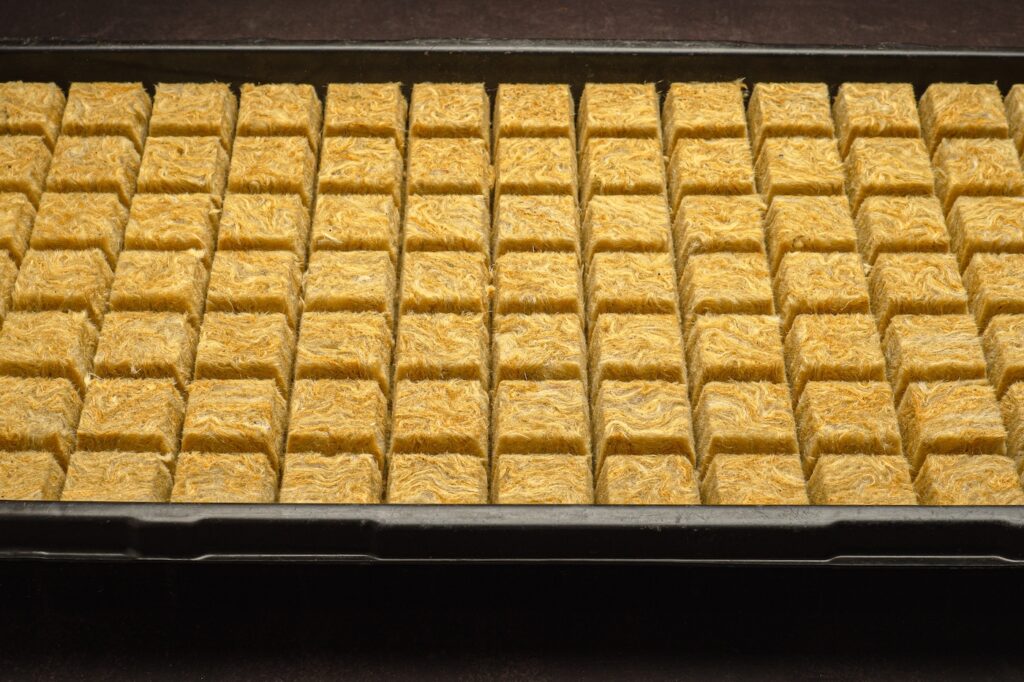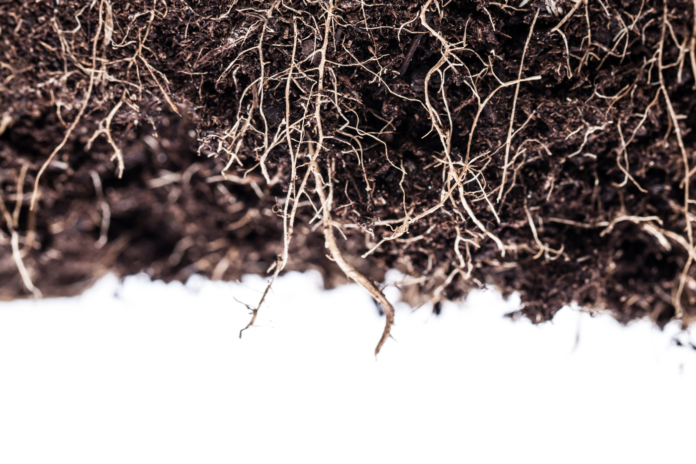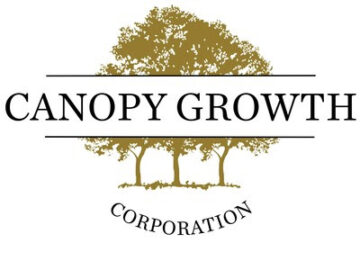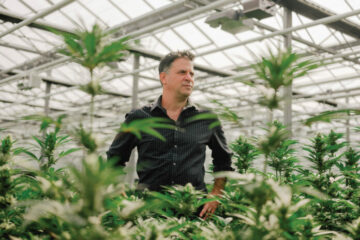Cultivators have no shortage of options when deciding where to bury their seeds, but each one comes with unique benefits and drawbacks. The growing medium, or media, is the substrate or substance that supports a plant’s root system and provides an environment for water, nutrients, and plant exudates to exchange. The cannabis plant can grow in almost any medium but prefers media that drains well, allowing for maximum air exchange in the root zone. Grow media can be a single ingredient or comprised of a blend of inputs depending on how the cultivator plans on feeding nutrients to the root system.
The most common components of growing media include coco coir, rockwool, peat moss, water, compost, sand, silt, and clay. These ingredients are often split into two categories: soil and soilless components. Choosing which ingredients will work best depends not only on how nutrients are delivered to the root system but also on how much space and time a grower has available.
In soil growing, the excrement from the fungi and microbes living in the soil’s microbiome provides chemicals a plant’s root system can consume. In a soilless growing medium, nutrients are supplied through water that’s easily absorbed by the root system. Knowing this distinction, many cultivators refer to soilless mediums as hydroponic systems.
Soil mixes
Soil mixes provide an ecosystem for the microbiome without the need for additional nutrient mixes. When a soil mix only relies on the microbiome to produce soluble nutrients for plants, it’s called living soil.

Living soils contain large amounts of compost that feed the microbiome, but they also have other organic materials that make up the composition and consistency. The soil consistency is determined by the ratio of sand, silt, clay pebbles, and organic matter present in the media.
The consistency affects how well the soil drains and the ability of the plants to uptake vital nutrients. Storebought soil mixes like potting soil are designed with the optimal consistencies and water retention, but DIY gardeners can follow recipes from resources like BuildASoil and learn how to conduct at-home consistency tests to improve drainage or water holding capacity.
Soil mix pros:
- Low maintenance option.
- Sustainable materials.
- Reusable to save expenses.
Soil mix cons:
- Nutrient production is restricted by the health of the microbiome.
- High-quality inputs can be costly but necessary to prevent heavy metal contamination.
Soilless mixes
Soil-less mixes effectively differ by how nutrients are supplied to the root system. Nutrient solutions are delivered to the plant through water during regular feedings. Alternatively, the root system can grow directly in the nutrient solution in a hydroponic grow.

Soilless mixes are composed of single ingredients or blends. The most common ingredients are coco coir from coconut husks, perlite vermiculite (volcanic glass), rockwool, rice hulls, and expanded clay pellets. The ingredients in soilless mixes determine how well the medium can drain, allowing fresh air to be exchanged in the root system.
Drainage impacts how often the plants need to be watered. Many cultivators use timed irrigation shots to keep the growing medium at the optimal moisture content. Others use a deep-water culture system where roots remain in water at optimal pH levels. Alternatively, ebb-and-flow setups see media drained and rehydrated on a timed basis.
Soilless pros:
- Growers have complete control of nutrient dosing.
- Growers have better control over aeration and drainage.
- Nutrient recipes are replicable, promoting consistent growth.
Soilless cons:
- There’s a constant need to maintain nutrition for the root zone.
- Some soilless media are only used for one grow cycle, which can produce excess waste with non-biodegradable materials.
How to choose a growing medium
One of the biggest considerations when choosing a grow media is the amount of space available. Soil mediums work well with large footprints where microbes and fungi have access to large amounts of food to consume. Soilless mixes are a good option where space is a limitation because the root system can take nutrients without being reliant on a microbiome to provide nutrition.
Time is also a factor. When growing in soilless media, the ongoing need to supply the root system with nutrients can become an intensive task. The nutrient solution applied to the root system requires close monitoring to ensure it has the right amount of nutrients at the proper levels for plant growth.
Pick your medium wisely
Choosing a grow medium is an important process and will ultimately come down to a cultivator’s feeding program. By deciding how the nutrients are going to be delivered to the root system, growers can determine what mix of ingredients will yield optimal plant growth. By providing the root system with the ideal environment to uptake all the critical elements it needs, cultivators have a much better chance to produce the large, resinous colas they desire.
- SEO Powered Content & PR Distribution. Get Amplified Today.
- PlatoData.Network Vertical Generative Ai. Empower Yourself. Access Here.
- PlatoAiStream. Web3 Intelligence. Knowledge Amplified. Access Here.
- PlatoESG. Carbon, CleanTech, Energy, Environment, Solar, Waste Management. Access Here.
- PlatoHealth. Biotech and Clinical Trials Intelligence. Access Here.
- Source: https://mgmagazine.com/business/growing-horticulture/growing-mediums-for-cannabis/
- :has
- :is
- :not
- :where
- $UP
- 2%
- a
- ability
- access
- Additional
- affects
- AIR
- All
- Allowing
- almost
- also
- amount
- amounts
- an
- and
- any
- applied
- ARE
- AS
- At
- available
- balancing
- basis
- BE
- because
- become
- being
- benefits
- BEST
- Better
- Biggest
- Blend
- blends
- but
- by
- CAN
- cannabis
- Capacity
- categories
- Chance
- chemicals
- Choose
- choosing
- Close
- coco
- come
- comes
- Common
- complete
- components
- composed
- composition
- Comprised
- concept
- Cons
- considerations
- consistency
- consistent
- constant
- consume
- contain
- content
- control
- costly
- critical
- Culture
- cycle
- day
- Deciding
- delivered
- Depending
- depends
- designed
- desire
- Determine
- determined
- differ
- different
- directly
- distinction
- Diy
- dosing
- down
- drain
- drained
- drawbacks
- during
- each
- easily
- ecosystem
- effectively
- elements
- ensure
- Environment
- excess
- exchange
- exchanged
- expanded
- expenses
- factor
- feeding
- follow
- food
- For
- fresh
- from
- gardeners
- glass
- going
- good
- Grow
- growers
- Growing
- Growth
- Hands
- Have
- Health
- heavy
- High
- holding
- How
- How To
- HTTPS
- hydroponic
- ideal
- Impacts
- important
- improve
- in
- include
- ingredient
- ingredients
- inputs
- intensive
- into
- IT
- jpg
- Keep
- Knowing
- large
- LEARN
- levels
- like
- limitation
- living
- maintain
- maintenance
- make
- many
- marijuana
- materials
- Matter
- max-width
- maximum
- Media
- medical
- Medical Marijuana
- medium
- mediums
- metal
- Microbiome
- miss
- mix
- mixes
- monitoring
- moss
- most
- much
- necessary
- Need
- needs
- New
- no
- nutrition
- of
- often
- on
- ONE
- ongoing
- only
- opens
- optimal
- Option
- Options
- or
- organic
- Other
- Others
- over
- photo
- plans
- plant
- plantation
- plants
- plato
- Plato Data Intelligence
- PlatoData
- preparing
- present
- prevent
- process
- produce
- Production
- Program
- promoting
- proper
- PROS
- provide
- provides
- providing
- ratio
- Recipes
- refer
- regular
- remain
- requires
- Resources
- restricted
- retention
- Rice
- right
- root
- roots
- SAND
- Save
- see
- shortage
- shots
- shutterstock
- single
- soil
- solution
- Solutions
- Space
- Space and Time
- split
- substance
- substrate
- supplied
- supply
- Supports
- system
- Systems
- Take
- Task
- that
- The
- their
- These
- they
- this
- Through
- time
- Timed
- to
- top
- two
- Ultimately
- unique
- uptake
- use
- used
- View
- vital
- Waste
- Water
- webp
- WELL
- What
- when
- which
- will
- with
- without
- Work
- world
- Yield
- Your
- zephyrnet
- zone













